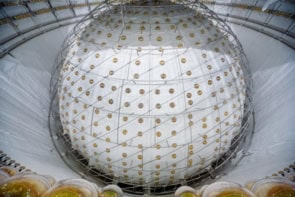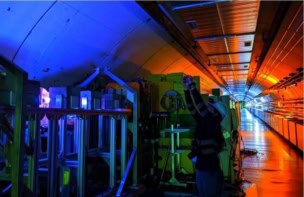
Physicists in the US reckon that cosmic-ray muons could help solve a major problem with nuclear waste – how to monitor the long-term storage of spent reactor fuel cheaply and safely. Applying detector technology normally used by particle physicists, the researchers have shown experimentally how the subatomic particles can be used on site to determine whether or not any fuel has gone missing from dry storage casks.
Spent nuclear fuel contains fission products as well as isotopes of plutonium, and must therefore be carefully monitored when removed from a nuclear reactor. It is first placed in a cooling pond for several years while short-lived fission products decay. It is then transferred to large and heavily shielded containers known as dry storage casks, located either close to the reactor or at a special waste facility.
Inspectors place special seals on the casks to reveal tampering. But if a seal degrades for any reason – it might, for example, simply corrode when exposed to the elements – then the cask in question ought to be sent back to a cooling pond for re-examination. As Matt Durham of the Los Alamos National Laboratory in New Mexico points out, the necessary handling and transport would be expensive and time-consuming. “All the nuclear workers I know in the US are careful professionals,” he says, “but there is always the possibility for accidents.”
On-site verification
Ideally, says Durham, the contents of casks would be verified on site. Numerous technologies have been put forward to do this, he notes, but all have their drawbacks – neutrons or X-rays, for example, cannot penetrate the casks’ thick shielding, while neutrinos would require enormous detectors. Muons, however, may provide the answer. Produced naturally by cosmic rays passing through the Earth’s atmosphere, muons penetrate material with a low atomic number – including a cask’s steel and concrete shielding – but are instead deflected by heavier elements, such as uranium fuel. Their degree of scattering as they pass through a cask should, therefore, reveal how much spent fuel is inside.
To put the idea to the test, Durham and colleagues at Los Alamos headed north to the Idaho National Laboratory. There they positioned a couple of muon trackers containing ionizable gas around a roughly 3 m-diameter, 5 m-high cask, with one tracker plotting the trajectories of muons as they entered the cask and the other mapping out the exit routes. The cask contained fuel removed from a Westinghouse power reactor in the 1980s. It was chosen because only 18 out of a possible 24 fuel assemblies were present, thereby allowing the researchers to try and identify the (known) empty slots.
There is always the possibility for accidents
Matt Durham, Los Alamos National Laboratory
Over the course of around three months, Durham and co-workers recorded about 450,000 muon tracks. With these data they plotted the muon scattering angle as a function of position along the cask’s diameter and also modelled how the scattering angle ought to vary if the 24 fuel-assembly slots are either all full or all empty. They then estimated the number of assemblies in six different groupings positioned along the cask diameter by gauging at each point whether the empirical plot was closer to the “all-full” or “all-empty” modelled curves.
Strong winds
Although they had to discard some of the data after strong winds shook the detectors for a few days, the researchers nevertheless correctly identified whether or not there were missing assemblies in four out of the six groupings. On this basis, they conclude that their technique is sensitive to the removal of a single fuel assembly from the centre of a cask. “This potentially represents a new method for inspectors to verify the content of a dry storage cask,” they wrote in a preprint uploaded to the arXiv server.
The researchers are now carrying out further modelling to establish whether their technique can be extended to more complicated “diversion scenarios”, such as the removal of just a portion of a fuel assembly or the replacement of an assembly with a dummy structure made from, say, lead. Durham says that the simulations look “promising” and that he and his colleagues aim eventually to test such scenarios experimentally. They also hope to carry out measurements on other types of dry storage cask.
Durham points out that although the technique was first proposed 10 years ago by his Los Alamos colleague Chris Morris, it is still quite new compared to say X-ray radiography. Nevertheless, he says that the “relevant authorities” at the International Atomic Energy Agency are aware of the work, and adds that “it has been considered” for probing the damaged reactors at Fukushima in Japan. Furthermore, he says it could be applied to the controversial nuclear deal with Iran, given that all spent nuclear fuel must be removed from the country inside heavily shielded containers.
Deployment in five years
David Ireland of the University of Glasgow, whose group has used muon scattering to inspect intermediate-level waste, says Morris and colleagues have carried out “a nice piece of work, despite the windy conditions”. He notes that although the use of naturally occurring cosmic-ray muons limits imaging speed, those muons have the virtue of not being dangerous to inspectors. Given sufficient support, and detector refinement, he estimates that a working system could be deployed “in the next five years or so”.



